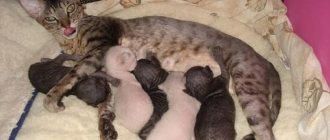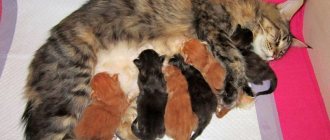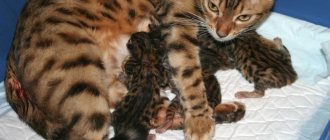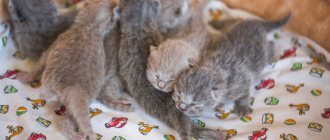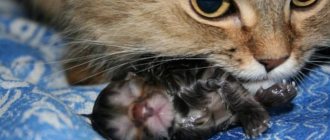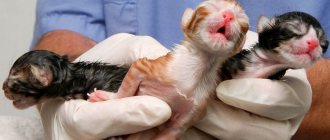Save the article:
If you are a happy cat owner, then without sterilizing your pet, sooner or later she will give you a litter of wonderful kittens. It’s good if this event is planned, then the cat will receive the nutrition, care and attention of all family members necessary during pregnancy. In this case, the cat’s birth will take place under the close supervision of the owner or veterinarian, which will help cope with possible difficulties or complications.
Although childbirth is a natural process, unplanned situations cannot be ruled out, so it is worth preparing for the climax long before it begins, which is what this article will help you with.
global $ads_google; //data-ad-slot=”2475549904″ $ads_google = empty($ads_google) ? false : true; ?> if ($ads_google == false) {?> $ads_google = true; ?> } ?>
How to prepare a cat for birth
A caring owner begins to prepare the cat for childbirth even before mating begins.
It is important to make sure that the pussy is healthy: an active lifestyle of the animal will contribute to the normal course of pregnancy and childbirth. However, towards the end of the term, it is better to ensure that the cat does not try to “take heights”, does not jump from cabinets and other high objects in the house: it can easily fall on its stomach.
On the contrary, you should try to stimulate British cats during pregnancy - these sloths are quite capable of lounging on the bed for a long period of time. And low mobility will not lead to a good result.
It is better to contact the veterinary clinic in advance and find out whether you can get an urgent consultation at any time of the day at “hour X”, and whether the institution provides the opportunity to give birth to cats at home .
Preparing the birth site
Just as a woman needs a breeding room, a cat needs a place to give birth to her offspring. It is best if it is something resembling a house for giving birth to a cat. In this place, not only will the fluffy balls be born, but also their first weeks of life will pass.
Why is it so important to prepare a place for your cat to give birth in advance? If she does not feel calm and protected, she will begin tossing around before the onset of labor, and then frantically dragging the kittens in search of a safe place.
How to help your beloved pussy during childbirth? Take care of everything in advance! What to make a house from: any spacious box will do, preferably with a removable top lid. A disposable absorbent diaper is placed in it. It makes sense to prepare in advance all the items that will help during obstetrics and place them close to the “maternity” house.
How to properly feed a cat that has given birth?
As soon as you find out that your pet is pregnant, it is extremely important to provide her with the highest quality feeding and housing conditions. It is highly advisable that before the planned mating, the cat has already received all the vaccinations it needs.
During pregnancy, vaccination is strictly prohibited. In addition, make sure that your pet does not have parasites.
To do this, you need to provide a sample of the animal's stool to a veterinary clinic. Many types of parasites are microscopic in size, and therefore you cannot see them with the naked eye.
Remember that from about the 20th day of pregnancy, the cat's need for nutrients gradually increases. Immediately after birth, nothing changes, since the pet’s body requires resources to restore itself and feed the offspring. We highly recommend avoiding dry food: canned diets specifically designed for feeding pregnant and lactating cats are ideal. They should be given until the kittens are completely weaned.
If there are no appropriate recommendations from a veterinarian, do not give your animal any vitamins!
Remember that an excess of them is many times more dangerous than a lack. In addition, it has been repeatedly proven that excessive amounts of vitamins contribute to the development of anatomical pathologies in the structure of kittens, which is why subsequent births will either be delayed or even end in the death of the mother herself.
First birth of a cat
Starting from 7-9 months, the cat is capable of reproduction. But don’t rush things: it’s much better if the pussy turns one year old, when 3-4 heats have passed. If the mating is successful, the cat's birth calendar will help calculate the timing of the birth of the offspring.
The first time is scary for everyone: both the cat and the owner. But nature took care of the animal’s strong instincts, so sometimes it’s enough for a person to just be nearby.
The first birth is quite normal if the cat is healthy. First, contractions intensify, followed by a reduction in the intervals between them.
After pushing, the baby appears, but first amniotic fluid will come out of the birth canal. The cat will want to sit down while the kitten is coming out, this should not be allowed!
The interval between the appearance of kittens during the first birth can frighten the owner - a break of up to one and a half hours is considered the norm, and labor itself lasts from several hours to one day. In some cases, labor lasts up to 36 hours
Since the cat is inexperienced, you can help her during childbirth and cut the umbilical cord with scissors at a distance of 2 cm from the kitten’s belly.
When you need help during childbirth
In certain situations, cats and kittens clearly need help. The latter will be required under the following circumstances:
- if the cat herself did not free the kitten from the amniotic sac;
- kittens do not come out for a very long time, this especially often happens in the last kitten;
- if the animal has not chewed the umbilical cord;
- part of the kitten has appeared, but the rest of the body does not climb.
In such cases, as a rule, the help of a veterinarian is unnecessary, and an experienced owner can help on his own. But you should call the veterinarian if the following signs occur:
- an unpleasant odor and red discharge came from the vagina;
- pregnancy lasts longer than expected - more than 70 days;
- the temperature rose and a fever began;
- very strong contractions, but kittens are never born.
Signs of labor in a cat
In order not to miss the onset of labor, owners carefully observe how the cat behaves before giving birth:
- a few weeks before lambing, you can easily notice the enlargement of the mammary glands;
- 1-2 days before the important moment, colostrum is slowly released;
- unusual behavior of a cat is difficult to ignore: this is the search and arrangement of a “nest”, changes in mood, anxiety, desire to hide, or extraordinary affection;
- drop in body temperature to 37°;
- appetite may disappear completely;
- The cat often licks the genitals.
The main thing is to let the pet feel that she is not alone: talk to her tenderly, pet her, arrange a House for her in a secluded corner.
global $ads_google; //data-ad-slot=”2475549904″ $ads_google = empty($ads_google) ? false : true; ?> if ($ads_google == false) {?>
$ads_google = true; ?> } ?>
Organization of the “family nest”
On average, pregnancy in cats lasts 65 days. The period may vary from 60 to 70 days. Childbirth before and after this period can be caused by pathologies (impaired pregnancy, fetal death, etc.) and be accompanied by complications. Therefore, it is important to closely monitor the condition of the animal during pregnancy, and especially in the last stages. After the 60th day of pregnancy, it is necessary not to leave the cat alone for a long period of time, so as not to miss the onset of labor.
Childbirth is a natural process. Sometimes it causes even more stress for the owner than for the pet itself. The cat's instincts will allow her to perform all the necessary manipulations, however, a person should monitor the process and intervene only if necessary.
Before the birth itself, it is important to provide the animal with an appropriate place. The cat itself will look for a secluded corner and spend a lot of time there. Sometimes the animal is huddled in the farthest and darkest corners, to which there is no access, and in an emergency it will not be possible to quickly provide help. Therefore, it is better to organize a “family nest” yourself. To do this, it is recommended to use special baskets for cats or use a cardboard box. One wall of the box is cut off so that the pet can enter it without any extra effort. At the same time, the remaining side should become an obstacle for the kittens to prevent them from crawling out.
The place should be cozy, spacious enough, and located in a quiet and peaceful part of the house. It should be remembered that the mother and offspring will spend the next few weeks here, and at first they will not be disturbed.
Stages of lambing for a cat
Labor is divided into three stages:
- Contraction of the uterus and its gradual opening. The external symptom is discharge - the mucous plug that covers the entrance to the cervix comes out. Contractions appear and become more frequent.
- Increased frequency of contractions, complete opening of the cervix. The movement of the fetus along the birth canal into the second phase is accompanied by the mother cat’s attempts to push the baby out: the animal tenses. Kittens are born mainly in the amniotic sac. If the new mother did not help the child cleanse himself of it and did not lick it, then a person should help - carefully use scissors to make an incision on the bubble in the area of the muzzle, and the kitten itself is wiped with a cloth. Usually the female, on her own, carries out the procedure of breaking the bladder and licking its remains from the kitten’s body. The duration is 5-60 minutes.
The kitten did not come out an hour after the start of this stage? Urgent call to the vet!
- Once the baby is born, the placenta begins to come out, which the mother can eat after the kitten has been licked. It is better to remember how many placentas came out - there should be as many of them as kittens.
The kitten finds the nipple, labor resumes, and the next cub appears. The interval between two kittens can be from 10 to 60 minutes.
The whole process takes on average 6 hours.
Signs that a cat is giving birth
The average gestation period for a cat is 62 to 65 days. On average they have four kittens. They may give birth several times a year, but are usually more fertile during the lighter months. During pregnancy, it is recommended to take a cat to the veterinarian for various reasons. Your veterinarian will help prevent complications, set an approximate due date, and promote a healthy pregnancy.
Changing a cat's diet during pregnancy is necessary so that they can better adapt to their body's new needs. We should note that their total food intake increases as pregnancy progresses, up to a few days before delivery. At this stage, the amount of food they eat will decrease or they may stop eating altogether.
© shutterstock
The approximate time of birth is related to changes in the cat's body temperature. By measuring it, the veterinarian can have an idea of the likely date of birth. There are other signs that a cat may give birth, such as preparing a nesting site. Here the cat is looking for a secluded and safe place to give birth and begin raising kittens. We can help by making the bed with soft materials and placing it in a warm place away from drafts and other possible obstacles. However, they can choose their own place and you should not force them to go somewhere they don't want to go. Their safety comes first.
Even before a cat gives birth, we may notice some symptoms of anxiety. They may scratch the ground, roll over, constantly get up and down, etc. We will also notice that their overall activity will decrease and they will spend more time lying down. Now that we know how to have a clear idea of when a cat will go into labor, we can discuss the actual event in more detail.
Giving birth to a cat at home
A responsible owner should know how to give birth to a beloved cat . First, prepare everything you need:
- a house that the cat will examine and “accept” in advance;
- towels or absorbent diapers;
- clean cloths or gauze;
- thick silk thread;
- scissors with rounded ends;
- alcohol for disinfecting scissors;
- hydrogen peroxide;
- streptocide in powder form;
- a pipette or syringe that can be used to suck out liquid from the baby’s nose;
- afterbirth bowl;
- warmer.
Easy birth
A cat's birth is considered easy when there is no need for human intervention. It will be enough to simply be close to the woman in labor. The main thing you need to take care of is that the mother should not accidentally crush her offspring. It is also important to monitor whether each afterbirth has come out. If suddenly some placenta is missing, then the cat’s discharge is observed for several more hours; the process may take a little longer.
An easy birth is not characterized by pus, mucus and blood.
Middle birth
Sometimes some complications arise during home birth. If the process is delayed, you need to stroke the cat from the side of the neck to the uterus.
If the cat is distracted and does not chew the umbilical cord, a person does this, treating the cut site with iodine. The newborn may not breathe: minor resuscitation will be required. The respiratory tract is cleared of mucus using a pipette or suction, and the oral cavity is examined. Anything that should not be there is removed with a rubber bulb. If breathing does not appear, the baby is picked up and carefully folded in half - several times in a row. You can also rub the baby with a rough towel and gently shake it upside down.
Difficult birth
global $ads_google;
//data-ad-slot=”2475549904″ $ads_google = empty($ads_google) ? false : true; ?> if ($ads_google == false) {?> $ads_google = true; ?> } ?> Childbirth turns out to be difficult when, despite everything, the kitten is not born on its own: the baby gets stuck in the birth canal, or two babies try to be born at the same time. Before calling the veterinarian and hoping for a caesarean section, there are a number of independent steps to take.
You need to understand that it is better to act and help the cat during childbirth than to later regret the misfortune that happened.
If labor stops or its result is zero, the cat can be taken for an ultrasound or x-ray. It may turn out that the kitten has died, or it is extremely large and has blocked the exit.
Sometimes it is necessary to turn the kitten over: a gloved index finger, lubricated with Vaseline, is inserted into the vagina. You need to carefully push the baby back and try to turn him over. If it is simply stuck, then it is picked up under the hanger and carefully pulled out with attempts.
How can you tell when labor is starting?
You can understand that a cat has begun to give birth by such a main sign as the appearance of contractions. They begin several hours before the event and gradually intensify so that they can be seen without palpation. When contractions begin, the woman in labor should be taken to a place prepared in advance and calmed down.
Further, the following signs indicate that labor has begun:
- lowering of the abdomen;
- increased urination;
- mucus secretion;
- breaking of water;
- rapid breathing.
Childbirth
Induction of labor
If the due date has come, the cat’s body temperature has dropped to 37°C, more than two days have passed, then you need to know how to induce labor in a cat. First, they try simple remedies: massage the tummy and nipples: this will cause the production of oxytocin, and it will start the process of contractions. It is dangerous to administer oxytocin on your own - physiological unpreparedness for lambing can lead to cervical rupture.
If two days have already passed, signs of labor are evident, but the process has not started, then contact a veterinarian.
How does the approach of labor appear?
So, the cat has been pregnant for about two months and the date of birth of the kittens is approaching, and with it the tension of the worried owners is increasing. How to understand that a cat is about to give birth is absolutely easy. Paying close attention to the main signs of the onset of labor in an animal, it is easy to notice how labor begins:
- The cat loses its appetite, it becomes motionless, lethargic (a clear indicator that in just a few hours it will be possible to give birth to your pet).
- Actively searching for a secluded place or, conversely, arranging a visually accessible area for the owners to view (meanwhile, it is better to determine the area for a long process in advance, although there is no guarantee that the animal will approve of it).
- Signs such as the release of a mucus plug and the appearance of vaginal discharge are indisputable proof that childbirth will be possible soon, literally in two to three hours.
- Your pet is about to give birth if her nipples are swollen and colostrum is released from them.
It’s easy for women to imagine how cats give birth, because they probably had to directly or indirectly face such a question. But when the mission of an assistant in the process of giving birth to kittens is entrusted to a man, he will have to familiarize himself with some features of the physiology of tailed animals so as not to make mistakes if necessary.
Possible complications
Cats are naturally strong creatures, but sometimes complications still occur. This was especially influenced by breeding selection. Observations have shown that Persian and Siamese cats often “delight” their owners with dystocia—difficult childbirth. When choosing a female kitten, it is better to immediately ask the breeders how the birth of kittens for this particular breed goes.
Bloody discharge in a cat after birth
Sometimes during labor a cat notices ichor oozing out. This is most often described as “my cat peed blood.” This is quite normal if there is little bleeding.
The alarming symptom normally disappears completely two days after lambing.
Sometimes there are really serious problems, expressed by bleeding from the vagina. Blood may have accumulated in the uterus, or if there are tears in the uterus or vulva. If a caesarean section was performed, then the blood may indicate broken sutures. But this is not just some bleeding, but really heavy bleeding that does not stop after 10 minutes. In this case, urgent veterinary help is needed.
The cat does not have milk after giving birth
First, felines, like humans, secrete colostrum. But when does a cat produce milk after giving birth? Colostrum is milk, only with a slightly modified composition. Colostrum contains a huge amount of maternal antibodies. After 2-3 days, colostrum is replaced with full-fledged nutritious milk. Thanks to nature, which, through the process of evolution, “thought out” everything, and the cat itself feeds its offspring!
But what if the cat gave birth, but there is no milk? There are several reasons: stress during a difficult birth, fear of the first-born cat, dormant maternal instinct.
The animal is provided with a comfortable environment, a nutritious, balanced menu, and milk is not spared. The bowl with food and drink is placed closer to the cat family. If food is far away, the mother may fear for her offspring, which also affects the quality and quantity of milk.
If milk does not appear, you will have to feed the newborn kittens yourself.
After giving birth, the cat came out with a bladder
Sometimes you can see a bubble coming out of the cat. Usually, this is the amniotic membrane - the kitten was in it before birth. During the normal course of labor, such a bubble ruptures inside the animal.
Sometimes during labor a bubble appears first. The cat may try to tear it apart, but the owner’s job is to prevent her from doing this. As soon as the bubble with the kitten comes out completely, you can break the shell.
If after giving birth a cat has an empty bladder, this is simply a developmental variation within the cat’s body, and it does not cause problems.
After childbirth there was a belly
global $ads_google;
//data-ad-slot=”2475549904″ $ads_google = empty($ads_google) ? false : true; ?> if ($ads_google == false) {?> $ads_google = true; ?> } ?> The cat has become a mother, the kittens are snoring nearby, but the pet still has a belly. This is the probability that not all babies were born at once. It is optimal to wait 12 hours and allow the natural process to take its course. But if the next day has already arrived and nothing has happened, then you definitely need to consult a veterinarian.
To make sure that not all the babies have come out, the cat’s stomach is felt. It is especially dangerous if the kitten is dead inside. If the baby inside cannot be felt, there is a possibility that the pet has intestinal problems: constipation, flatulence, feces, helminthic infestation.
Eclampsia in cats after birth
Eclampsia is a severe postpartum condition that is not that rare. Due to the production of milk, the amount of calcium in the animal’s blood decreases, and it may even cease to be absorbed by the body.
Signs of eclampsia:
- excessive saliva production;
- poor coordination of the animal, confused movements;
- concern;
- convulsions;
- the temperature rises.
If you notice these warning signs, contact your doctor immediately! Further development of the complication leads to death.
To avoid such danger, during pregnancy and after the birth of kittens, the cat is given calcium supplements. But first, they take a blood test to determine the need for such prevention.
Cat doesn't eat after giving birth
The norm is that a cat should not be hungry for another 5-6 hours after birth.
The main thing is that the pet does not refuse water. If the cat has not eaten for a long time, first she is offered broth. Low-fat cottage cheese, kefir, and even sweet tea can cause your pet’s appetite.
If your cat develops diarrhea, it means she has eaten too much afterbirth. With such a disorder, refusal to eat is understandable. The treatment will be sorbents and Ringer's solution. This will relieve intoxication. Enveloping substances will help protect the mucous membranes. Ringer's solution will prevent dehydration.
As soon as the cat feels better, she will ask for food herself.
The cat does not go to the toilet after giving birth
The body and uterus will gradually recover after the end of labor, so the animal does not rush to the tray. Don't panic if you brought the tray closer to her and the new mother ignored it.
It is considered normal if the cat does not go to the toilet after giving birth for up to 4 days.
The lack of desire to visit the latrine may be caused by exhaustion - all the liquid goes into the milk.
How does this happen?
After the first contractions have occurred, you need to understand that the process is nearing its end. But before active labor and immediate pushing, the pet will have to endure a lot. In general, it is convenient to divide what is happening into several stages:
- Opening of the birth canal and cervix (if the cat’s water breaks, this indicates the onset of labor).
- Birth of kittens (the birth interval for each of the litter's cubs is normally from 15 minutes to half an hour).
- Exit from the uterine cavity of the placenta.
Before you give birth to a cat, you need to prepare additionally. Definitely, you need to be prepared for the fact that you may need additional materials and simple pharmaceuticals. Before labor begins, it is important to have on hand:
- clean gauze;
- pipette;
- petrolatum;
- scissors;
- heating pad;
- towel.
Initial stages of labor
You should not rule out the possibility that you will have to call a veterinarian if something goes wrong. Labor in cats usually lasts about 12 hours. As with women, the first time for furry pets often takes a long time and is much more painful. The initial stage can make up most of the entire period of labor.
Contractions cause discomfort in the animal, it begins to breathe quickly and behave restlessly. But it is important to know that it is absolutely forbidden to shout at a cat in such a state, no matter what it does. It is necessary, first of all, to calm the pet down and give it the opportunity to feel protected.
How to help a cat in case of weak labor?
When labor does not activate for quite a long time, especially if the cat’s water broke about 30 minutes ago, it is urgent to take serious action and induce labor. This should be done without unnecessary hesitation, however, even a chaotic rush can only harm the pet.
Here's how you can help your cat:
- The owner's fingers should be lubricated with Vaseline.
- Gently insert your fingers into the vagina and begin to slowly pull out the kittens.
- The cat's belly must be supported with your free hand.
- If the contraction stops, it is important to massage the back and stroke the stomach, stimulating the appearance of new attempts.
- Under no circumstances should you pull the kitten by the head. Otherwise, you can break his cervical vertebrae, which, naturally, will lead to death.
It is not difficult to induce labor, but it is advisable to resort to such a procedure only in exceptional cases.
Immediate birth of babies
Cat birth moves to the next stage when the amniotic sac ruptures. The discharge of amniotic fluid helps to lubricate the vaginal passage. Usually a few minutes pass between the rupture of the amnion and the birth of the first baby. All cats have completely different durations for such breaks: for some, everything goes away in 5 minutes, while other animals give birth to their kittens in up to half an hour. But it is important to know that the time interval between the birth of the remaining cubs should not exceed a 30-minute pause.
A cat gives birth to kittens within 2-4 hours. Then a completely natural process continues, which does not require any human intervention. There is no need to do anything, because on an instinctive level the animal itself must accept its offspring. The mother quickly licks the face of each kitten as each of them is born, gnaws the umbilical cord and removes the amniotic membranes.
The third and final stage of labor involves the separation of the placenta, which comes out on its own a few minutes after the kitten is born. Many owners may not know that cats usually eat placenta. In addition, after such “food”, young mother cats may develop gastrointestinal upset.
Caring for a cat after birth
global $ads_google; //data-ad-slot=”2475549904″ $ads_google = empty($ads_google) ? false : true; ?> if ($ads_google == false) {?>
$ads_google = true; ?> } ?>
The cat must be carefully looked after. She is raising the young generation, which will stay with her for up to 8-10 weeks. In order for the cat to have the strength to do this after giving birth, it requires good nutrition and fresh water nearby.
What is useful to feed a cat after giving birth? Among industrially produced feeds, they use specialized products for pregnant and lactating cats.
For the first 12 days, a nursing mother’s menu includes easily digestible, nutritious and natural foods: fermented milk, vegetables, cereals, a small amount of boiled lean meat.
Artificially bred cat breeds (Chausie, Elf, Savannah, American Curl), as well as British cats, may suffer from a change in diet, so their menu remains unchanged.
After 12 days, the animal’s usual food, including fish, is added.
Every day, carefully check your pet’s nipples for the presence of mastitis.
Now you are prepared and will be able to have a second birth after a period of time!
Abnormal birth
It happens that a cat needs outside help. There are situations in which the owner is able to help the animal and when immediate professional help is needed.
Providing obstetric care
If birth does not occur after the head or paws emerge, the birth canal is lubricated with Vaseline or lubricating gel. When a kitten comes out in a bubble, and the mother is in no hurry to release it, the person delivering the baby has to do it.
Cut the bubble, release the kitten, wrap it in soft cloth, and turn it face down. Bend the body so that the chest is in contact with the knees. Straighten and repeat the procedure. If there is no sigh, artificial respiration is performed. Mucus is sucked out of the nasal and oral cavities with a pipette and the kittens are rubbed with a terry towel. When the next kitten is born during resuscitation, the rescued one must be wrapped in cloth and placed under a lamp. Returning to resuscitation is acceptable after you are confident that the newborn kitten is breathing normally.
If the mother has not bitten the umbilical cord within 15 minutes, it is tied with a sterile thread four centimeters from the tummy, the stump is cut off and disinfected. In the case when the placenta does not come out for a long time, put on a glove and remove it from the birth canal.
When to call a veterinarian
Professional help is needed in the following situations:
- 10 weeks have passed since the mating, but labor has not occurred.
- The first stage of lambing lasts more than a day.
- The fetus remains in the birth canal for more than half an hour.
- More than five contractions without a kitten emerging.
- Hyperthermia.
- Vaginal discharge is dark brown or red.
- Unpleasant smell of excrement.
If conservative treatment does not lead to the desired result, the veterinarian performs a caesarean section. The presence of the owner during lambing and his calm, caring behavior have a beneficial effect on the cat’s condition.
We invite you to join our Zen channel and group on VKontakte or Odnoklassniki, where new articles for pet owners are published.
Similar articles:
- What should you protect your pets from during the New Year holidays?
- What indoor plants can harm cats?
- What dangers do Christmas decorations pose for cats?
Sterilization of a cat after birth
A cat's birth may involve complications, one of which may require a caesarean section. Of course, this is not an indicator for sterilization, but still a clear sign of a problem in the reproductive system.
It does not seem possible that a loving owner would again subject a furry creature to another painful birth or another caesarean section. In these cases, the clinic is consulted about sterilization. If a cat is sterilized during a caesarean section, then the procedure is more dangerous than the one that will be prescribed according to plan. In addition to complications from the operation, the cat may refuse to feed its offspring.
When is a cat spayed after giving birth according to plan? Usually the procedure is prescribed at the end of lactation, that is, 2.5-3 months after the birth of kittens. The kittens are isolated, or a blanket is put on the cat - milk should stop forming.
The veterinarian will advise which method of sterilization is most suitable for the cat who gave birth.
Normal birth
The following stages of lambing are distinguished:
- First stage. Characterized by an increase in pain. Bloody excreta appears from the swollen vulva. Contractions begin. The duration of stage I is 12…24 hours.
- The second stage is the birth of the first kitten. An amniotic sac (bubble) appears. Liquid flows out of it, the cub moves forward with its head or hind legs. The cat frees its cub from the bladder, licks it, bites the umbilical cord. The kitten takes its first breath, accompanied by meowing. The mother applies it to the nipple and eats the afterbirth.
- The third phase is manifested by a temporary cessation of contractions after the release of each kitten and placenta. It is not recommended to let your cat eat more than two placentas. After 10...15 minutes, new attempts and the birth of the next one follow.
The cat releases the kitten from the amniotic sac.
It is necessary to count the released placenta. Their number should be equal to the number of kittens born. If any of the placentas do not come out, you need to contact your veterinarian. In total, the second and third stages of labor last 2...6 hours, with an average of 3...5 kittens being born.
Delayed birth is considered a variant of the norm. The cat is busy with the kitten, and suddenly, after 1/2…3/2 days, labor resumes.
The amniotic sac comes out
Helping a cat before giving birth
To begin, take a pair of scissors and carefully trim the long hair around your nipples. The fur, “wet” from milk, becomes sharp peaks after drying, which are aimed at the kittens’ eyes - once, and also prick the cat’s stomach - two. Anxiety during feeding can cause your cat to stop feeding her babies prematurely.
It would be a good idea to trim the hair around the vagina, from the “pants” and from the bottom of the tail, especially if the cat is long-haired.
A cat's behavior changes before giving birth. She no longer jumps, but carefully walks around the entire house, carefully examining all the nooks and crannies in search of the ideal place for a nest. He may choose several secluded places at once, which will not suit you at all. Help the cat decide on a place! An ordinary box of sufficiently large size with a hole 10 cm from the floor and a diameter of 15-20 cm will be gratefully received by your overweight pet.
Don't rush to look for bedding! - It's too early! Place several layers of old newspapers in the box, and place the box itself in a dark, warm, draft-free corner. A cat, having discovered such a nook, will happily spend its prenatal holiday there, tearing up newspaper with its claws and building a kind of nest for the babies from the scraps.
3-4 days before the expected birth, massage the cat's nipples between your thumb and forefinger dipped in sunflower oil. This daily kneading of the nipples will prepare them for the “sucking period” after the babies are born.
Do not let your cat out of the house in the last week before the expected due date! She may really beg, run along the windowsill, try to sneak out after your feet, etc. This is a manifestation of the instinct to conceal childbirth and born offspring. As a rule, if a cat gives birth for the first time outside the home, she will continue to do the same. Don't let this happen!
Help the cat calm down and calmly give birth to its first children in your home under your careful supervision.
That's all the simple advice on the topic: “How to help a cat give birth at home without any problems?”
Now, on the merits of frequently arising questions about childbirth and the behavior of a cat and its owners
- When does birth (lambing) occur?
In some cats, birth (lambing) occurs on the 62-63rd day after fertilization. There are also those whose pregnancy lasts from 55 to 60 days. For Siamese, labor begins from the 63rd to the 65th day. In non-English breeds, birth is only expected from the 65th day. Egyptian Mau cats give birth to kittens on the 71st to 73rd day.
In short, the period from 60 to 70 days can be taken as normal pregnancy periods before the cat gives birth. If, after 2 weeks after the expected date of birth, the cat is still in the blissful prenatal period, not showing any anxiety and clearly not intending to give birth to anything, then, most likely, your beauty has a false pregnancy - a “spoon”.
But! If the cat is very worried, in pain, contractions have begun and suddenly ended, the animal is breathing with its mouth open, screaming, or dark or purulent discharge has appeared from under its tail - see a doctor immediately! Urgently!!!
- How to understand that a cat is giving birth?
The period of expulsion of fetuses (childbirth, lambing) is characterized by enlargement and swelling of the labia, the appearance of mucous discharge, engorgement of the mammary glands, and decreased appetite. The most important harbinger of an approaching birth, the first symptom is a drop in the expectant mother’s temperature to 37-37.5*C. This temperature accurately indicates that there are no more than 24 hours left before lambing! As soon as the temperature returns to normal (38-39*C), there are a couple of hours left before the birth.
- How do cats give birth and what is the natural course of labor?
Cats usually do not need birthing assistance. The course of labor can be divided into three phases:
- Preparatory (opening the birth canal) contractions
- Excreting contractions (expulsion of fetuses)
- Postpartum (uterine contraction) contractions
After the mucus plug, which prevented the entry of microbes, is removed, which indicates the opening of the birth canal, the process of birth as such begins.
Under the influence of contractions and contraction of the muscles of the abdominal wall, small kittens move towards the genital opening and are slowly pushed out. The placenta (amniotic membrane) comes out simultaneously with the baby or within 20-30 minutes. after the birth of a kitten. No need to be scared if the baby was born in the placenta! – There is a proverb: “I was born in a shirt!” He will be happy!” – this is just about a similar situation.
Contractions in a mother cat last from 2 to 7 minutes, pauses between them are 5-15 seconds.
- How does a cat give birth for the first time and are there any differences from subsequent births?
Childbirth takes place in the same way, according to a single pattern, whether for the first time or for the second time. The only difference can be in the speed of opening of the birth canal. The body of a first-time cat may need a little more time for this.
- How are kittens born?
There are no secrets here! Since a cat has multiple pregnancies, it is natural to expect that there will be more than one kitten. At the very beginning of pregnancy, the fetus is placed in one of the fragments of the bicornuate uterus and is a kind of lemon, where the peel is the “shirt”, the cell is the corresponding sector of the uterine horn. At birth, the “shirt” is torn, the amniotic fluid flows out, and the kitten revealed to the world, having taken its first breath, begins to squeak quietly. What arouses the interest of the mother, who carefully licks the baby, removing excess mucus from his face, nose and eyes, and then eats the afterbirth. Instinct forces the newborn to “poke” the nipple with its nose and immediately suck on it, stimulating further contractions of the uterus and thereby helping the birth of other brothers and sisters.
- How long does it take for a cat to give birth for the first time?
You will be surprised - up to 32 hours! Kittens appear every 10-30 minutes, although these periods are individual for each animal. After the first birth, you will already know how much time passes between the birth of your cat’s first, second, and next.
Nature has provided a special “gentle” option for young animals: after the birth of one or two kittens, the cat calms down and childbirth (as it were) stops. However, after 10-20 hours, labor resumes and the cat “gives out” the kittens remaining in the womb. This is normal as long as she doesn't pass out from exhaustion.
At the first signs of a cat’s weakness and obvious exhaustion from childbirth, call a veterinarian who knows what medications and in what doses to stimulate further labor.
Don’t trust the ubiquitous “I-also-gave birth-I-know-what-to-do”!
Incorrect and untimely administration of contracting or dilating drugs can lead to torsion of the uterine body (excessive contractions), bleeding (administration of dilating drugs) or uterine rupture under the influence of increased efforts when the fetus is not ready to expel. All three scenarios lead to the death of the animal if qualified assistance is delayed.
As soon as the young mother agrees to eat a hearty meal after giving birth, the process can be considered complete.
- How many kittens can a cat give birth to for the first time?
Everything will depend on a combination of data such as the heredity of the cat and the stud cat, the age of the mother herself, the correct timing of mating, etc. Usually, even in the first birth, a cat is not limited to one offspring; such an outcome is very rare. No less than two! So that you have no doubt that after 30 hours there is still someone left inside the mother, 10-15 days before the birth, take a picture of the “intrauterine contents” and count the offspring according to the picture.
Experienced cat owners can, by palpating the cat's abdomen, find out (determine) how many crumbs are expected, but an inexperienced person should not do this, so as not to damage the soft, unformed fruits.
- Does a cat need help when labor has already begun?
Regardless of whether this is the first birth or the second-tritium, your help will mainly consist of kind words and light massage stroking the sides and abdomen of the cat during contractions. Cats love when their owners are close to them, and moral support from you in such a costly task as childbirth will not be superfluous.
Physical examination may also be necessary if the expulsion of the fetus occurs too quickly, and the mother simply does not have time to “process” one baby when the next one is already moving along the birth canal.
Your actions will be as follows:
- Carefully rupture the amniotic sac in which each newborn is “packed.” You can use sterile scissors.
- Remove mucus from the kitten's muzzle, mouth and nose with a sterile, slightly damp cloth. Never use wet packaging wipes!
- Use a clean, dry terry towel to dry the entire baby and vigorously rub his back and forth with the same towel several times. Usually, after such actions, the kitten begins to make a quiet squeak, which arouses the keenest interest of the mother. Put the kitten under the mother's side, then she will handle it herself.
- If the mother cat does not have time to cope with the umbilical cord (usually she chews it herself), then you must do it for her. No! No need to chew anything! Take the scissors you used to open the “shirt” and, squeezing the remaining blood in the umbilical cord towards the kitten’s tummy, twist it several times through your index finger so that there is 10-12 cm on your finger. The rest can be cut off. A 10-centimeter piece will soon dry out and fall off in a couple of weeks.
- The cat eats the afterbirth, known as amniotic membranes or the nutrient residue of the placenta. Immediately and without remainder.
If the placenta has been lying next to the woman in labor for more than 10 minutes, remove it - the placenta left “unattended” very quickly becomes contaminated with various bacteria and can become dangerous to the cat’s health.
If there are a lot of kittens, then the cat itself will refuse the extra “protein” and you will quickly remove them.
Pregnant cat
After your beauty has returned under her native roof, she may continue to emit inviting cries for some time, although the mating has already taken place. Make sure that she does not leave her home again without your knowledge. Up to the complete cessation of conscription.
If, after 2 weeks after visiting the cat, the cat comes into heat again, then this is a clear sign that fertilization has not occurred and mating can be considered unsuccessful. What to do when the cat bursts into inviting cries again? – Send her for “re-tying”!
A successful option for a visit to the “groom”: your cat is jumping around the house and looks completely satisfied, radiating health and joyful excitement with its entire appearance. And most importantly, you experience a long period of long-awaited (no, blissful!) silence.
2-3 weeks after a successful mating, the cat can again begin to roll on the floor, albeit without musical accompaniment, and you will notice how round it is, and how its nipples have become larger and pinker.
When a cat gives birth for the first time, she does not always have time to properly manage the time remaining before giving birth and do everything correctly. What to do if the cat is a “firstborn”? To help!
Normal pregnancy process, stages and timing
In a healthy animal, the process of pregnancy and childbirth occurs without the need for intervention or assistance.
In purebred, small, problem cats, childbirth may occur with complications. In more developed countries, there is a special profession - zooobstetrician, a specialist responsible for the favorable course of childbirth, preserving the life and health of the mother and offspring. In “our realities,” all responsibility falls on the shoulders of the owners and general veterinarians. On average, a normal cat pregnancy lasts 60–65 days, but the period can vary by 7–10 days depending on the breed and body composition of the expectant mother. Conventionally, pregnancy is divided into 3 stages:
- Mating – 3 weeks: after mating, the cat experiences swelling of the mucous membranes of the genital tract, but this does not guarantee pregnancy. Clear signs are observed from the third week: Drowsiness, decreased appetite and activity.
- Requires affection and attention.
- Vomiting (no more than 3 times a day, no longer than 2-3 days).
- Distinct pigmentation of the mammary glands - from light to bright pink.
- An enlarged uterus, which can be detected by a veterinarian by palpation.
- 4-6 weeks: Rapid growth of the “babies” and “rounding” of the cat. By week 6, the amount of fluid in the uterus increases, and the kittens begin to make their first movements.
- Kittens can be “felt” when gently palpated.
- The cat eats and sleeps more, otherwise behaves as usual.
- 7–9 weeks: Kittens are actively moving. The movements are clearly visible to the naked eye, especially if the cat is sleeping.
- Swelling of the mammary glands, release of colostrum.
- Some cats have a whitish vaginal discharge, which is normal.
- Increased anxiety and making a “den”.
